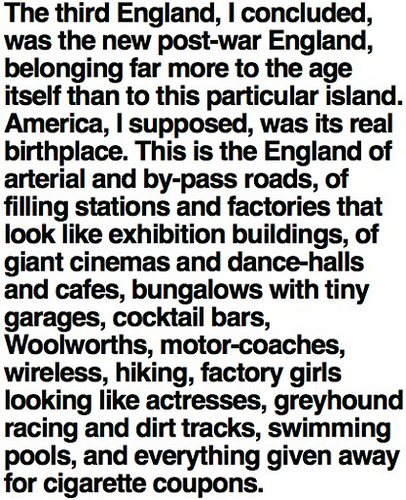A documentary on BBC4 the other day reminded me of a favourite bit of JB Priestly - his idea of the Three Englands:
"There was first, Old England, the country of the cathedrals and minsters and manor houses and inns, of parson and Squire; guide-book and quaint highways and byways England…
Then, I decided, there is the nineteenth-century England, the industrial England of coal, iron, steel, cotton, wool, railways; of thousands of rows of little houses all alike, sham Gothic churches, square-faced chapels, Town Halls, Mechanics’ Institutes, mills, foundries, warehouses, refined watering-places, Pier Pavilions, Family and Commercial Hotels, Literary and Philosophical Societies, back-to-back houses, detached villas with monkey-trees, Grill Rooms, railway stations, slag-heaps and ‘tips’, dock roads, Refreshment Rooms, doss-houses, Unionist or Liberal Clubs, cindery waste ground, mill chimneys, slums, fried-fish shops, public-houses with red blinds, bethels in corrugated iron, good-class draper’s and confectioners’ shops, a cynically devastated countryside, sooty dismal little towns, and still sootier grim fortress-like cities. This England makes up the larger part of the Midlands and the North and exists everywhere; but it is not been added to and has no new life poured into it…
The third England, I concluded, was the new post-war England, belonging far more to the age itself than to this particular island. America, I supposed, was its real birthplace. This is the England of arterial and by-pass roads, of filling stations and factories that look like exhibition buildings, of giant cinemas and dance-halls and cafes, bungalows with tiny garages, cocktail bars, Woolworths, motor-coaches, wireless, hiking, factory girls looking like actresses, greyhound racing and dirt tracks, swimming pools, and everything given away for cigarette coupons."
Excerpted from English Journey by J.B. Priestley (1934). Penguin 1984, pp. 371-375. Lifted, with thanks, from here.
I don't know enough about Priestly to know, but it sounds to me like he had most affection for the second England, where I guess he'd come from, and he wasn't that excited about the third one. Of course to us now, that England of tiny garages, cocktail bars, Woolworths, motor-cars, wireless, hiking etc sounds like a golden age. It's now the mythic and appealing England poised between Empire and austerity. I don't think Priestly meant that these Englands replaced each other, but that they lived alongside each other, waxing and waning in influence and reach.
It made me wonder what other Englands we'd talk about now. How many are we up to? (And I suppose we might even acknowledge the existence of the rest of the UK at some point.)
I guess you could point to the make-do-and-mend England of the post-war years, or the optimism of post-war planning and the white heat of technology. They're still around. Or the grimness of Thatcher's England (though that's probably mostly about the decline and destruction of the second England). Or there's the England of universal consumption; shopping centres, call centres and dockland developments. Or multi-ethnic England. Or broadband and Sky+ England. Etc.
Though, actually, Priestly's Englands are deeper than that; 200 year+ Englands. Feudalism. Industry. So maybe we're still exploring the third one, and actually 'wireless, hiking, factory girls looking like actresses, greyhound racing and dirt tracks, swimming pools, and everything given away for cigarette coupons" sort of sounds like now too.
Anyway. It's a good thing to think about.
